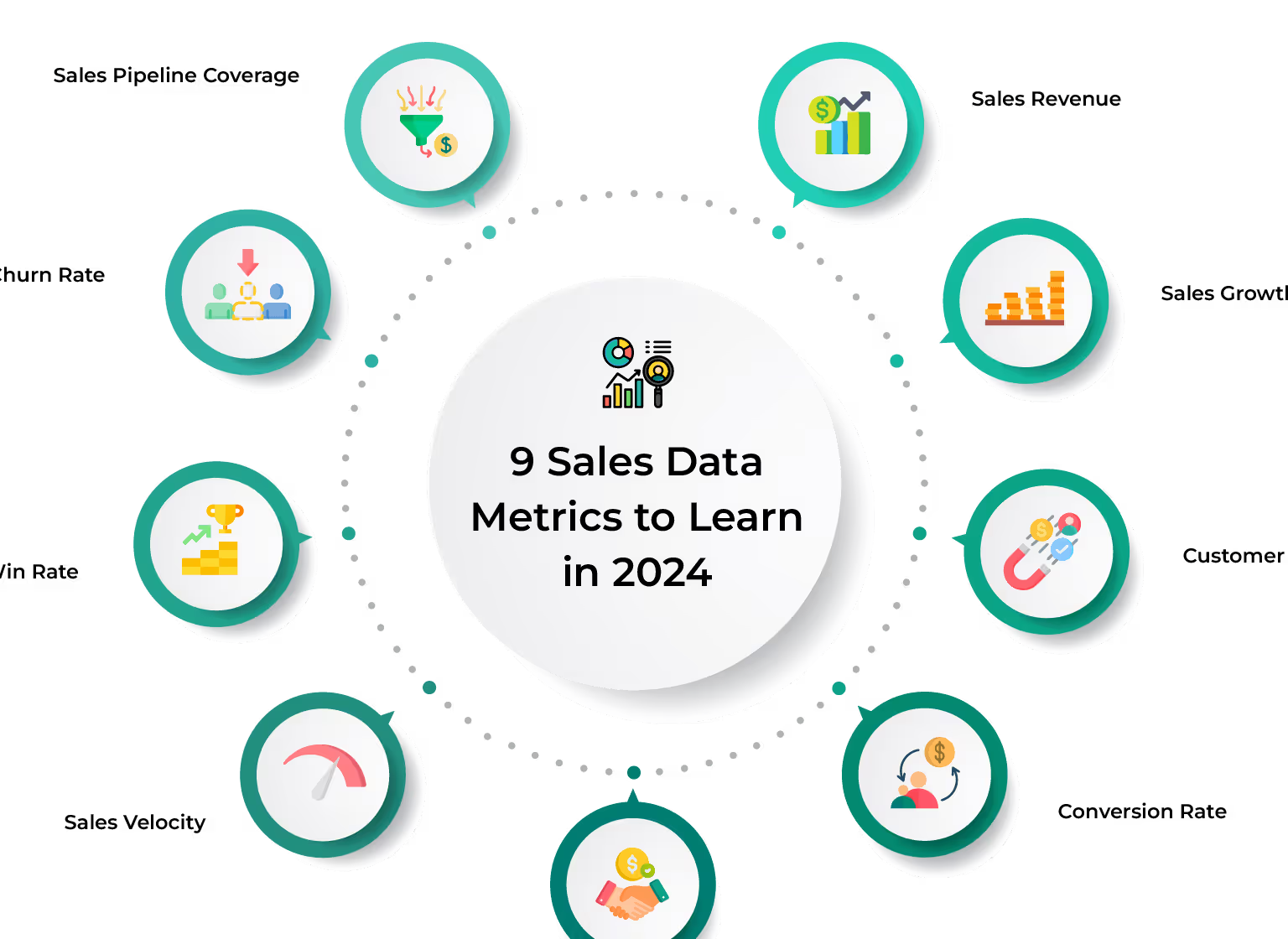
Blog
What's the Trick: Simple Steps to Sales Excellence with Sales Data Analytics in 2024
January 15, 2024


Key Insights
It's the year 2024 and there is no way to avoid incorporating analytics in sales operations.
The inevitability of automation tools and the advantage of leveraging the data that they provide has been reiterated time and again.
As we enter a new year with new objectives and targets, there needs to be a refurbishing of old practices and looking for newer ways to revamp your sales process and company operations.
In the dynamic landscape of 2024, mastering sales performance analysis is paramount for business success. This article will explore the realm of sales data analytics, unravel its benefits, and spotlight 9 indispensable sales metrics, providing a comprehensive guide for optimizing your sales strategy.
So scroll down for more.
What is sales data analytics?
Sales data analytics refers to gathering, processing, and interpreting data related to sales activities using data analysis tools and techniques. The goal is to gain valuable insights that can be used to improve sales performance, optimize strategies, and make informed business decisions.
Sales data analytics is widely used across industries to enhance sales performance evaluation, identify growth opportunities, and optimize marketing efforts. It empowers businesses to make data-driven decisions, ultimately leading to improved performance and increased competitiveness in the market.
Benefits of sales data analytics
Sales analytics empowers businesses with a competitive edge through its ability to uncover patterns, trends, and customer behaviors, making sales data analysis an invaluable tool for informed decision-making and strategic planning in 2024.

Improved Decision-Making
Performing data analytics for sales empowers decision-makers with accurate and timely information, enabling them to make informed and strategic decisions. This helps in effective resource allocation, better-targeted marketing efforts, and optimized sales strategies.
Enhanced Sales Performance
Analyzing sales data helps organizations identify areas of strength and weakness in their sales processes, facilitating targeted improvements, training, and coaching to enhance the performance of sales teams with relevant sales methodology examples.
Better Customer Understanding
Sales and data analytics help businesses understand their customers' behaviors, preferences, and needs. This insight allows for the creation of targeted marketing campaigns, personalized customer experiences, and improved customer satisfaction.
Forecasting and Planning
Sales data analytics enables predictive analytics that helps businesses forecast future sales trends, demand patterns, and customer behavior. This information is crucial for inventory planning, resource allocation, and overall business planning.
Sales Pipeline Visibility
Sales analytics provides a clear view of the sales pipeline, allowing organizations to track leads, opportunities, and deal progress. This visibility helps in identifying drawbacks, optimizing the sales funnel, and ensuring a smooth and efficient sales process.
Targeted Marketing Campaigns
Analyzing customer data enables businesses to create targeted and personalized marketing campaigns. This ensures that marketing efforts are directed toward the most promising leads and potential customers thereby improving the overall return on investment for marketing activities.
Measurable Performance Metrics
Sales analytics provides clear and measurable key performance indicators that allow businesses to track and evaluate the success of their sales initiatives. This data-driven approach facilitates continuous improvement and optimization of sales processes.
Implementing a robust sales tracker is an essential component of leveraging sales analytics, enabling businesses to monitor real-time performance metrics, identify areas for improvement, and adapt swiftly to market dynamics for sustained success and growth.
For further reading, check How to Master Sales Performance Analytics: Key Metrics to Track.
9 sales data metrics to learn in 2024
Tracking and monitoring key sales metrics is essential for evaluating the performance of a sales team and making informed business decisions. Here are nine crucial sales data metrics that organizations commonly track:

Sales Revenue
Sales revenue is the total income generated from sales and it is a fundamental metric that reflects the overall financial health of the sales department and the organization as a whole.
Sales Growth
Sales growth is the percentage increase in sales revenue over a specific period and it indicates the effectiveness of sales strategies and the ability to capture new business opportunities.
Customer Acquisition Cost
Customer acquisition cost, the average cost to acquire a new customer, is calculated by dividing the total sales and marketing expenses by the number of new customers acquired. Adhering to sales ethics in this process, CAC helps assess the efficiency and effectiveness of customer acquisition efforts and ensures that the cost of acquiring a customer is justified by their lifetime value.
Conversion Rate
Conversion rate is the percentage of leads or prospects that result in a successful sale. Attaining a high conversion rate indicates a well-optimized sales process and effective lead nurturing, contributing to overall sales success.
Average Deal Size
The average deal size is the average monetary value of a sales deal or transaction. Tracking this metric helps in understanding the typical value of sales opportunities and allows for better resource allocation and forecasting.
Sales Velocity
Sales velocity is the rate at which deals move through the sales pipeline, calculated by multiplying the number of opportunities, the average deal size, and the conversion rate. It provides insights into how quickly deals are progressing and helps identify areas for improvement in the sales process. Users can use our free sales velocity calculator to easily and accurately calculate this important metric.
Churn Rate
Churn rate refers to the percentage of customers who stop using a product or service over a given period. It is a critical metric for subscription-based businesses and helps in assessing customer satisfaction, retention efforts, and the overall health of the customer base.

Sales Win Rate
Sales win rate is calculated as the percentage of won deals out of the total number of opportunities pursued. Companies with a high win rate indicate effective sales strategies, while a low win rate may suggest the need for improvements in sales tactics or targeting.
Do not work in the dark, analyze your winning percentage calculator with Kennect.
Sales Pipeline Coverage
Sales pipeline coverage is the ratio of the total value of deals in the sales pipeline to the sales target. It provides insights into the likelihood of achieving sales targets, helping organizations assess the health of their sales pipeline and make necessary adjustments.
Regularly monitoring these sales metrics enables businesses to identify trends, make data-driven decisions, and continuously improve their sales strategies for optimal performance.
For further reading, check Apply our Advanced Sales Tracker to Revolutionize Sales Management.
Final Thought
Businesses that effectively utilize sales data analytics gain a competitive edge by proactively positioning themselves ahead of evolving market trends.
Incorporating sales performance intelligence into this monitoring framework equips enterprises with the foresight needed to proactively respond to market shifts, refine strategies, and stay ahead of competitors, fostering agility and resilience in the dynamic business environment of 2024.
This proactive approach helps businesses to capture a significant market share and position them to consistently outperform competitors.
The valuable insights derived from sales analytics empower businesses to make informed decisions, optimize processes, and enhance overall efficiency.
Building sales operations that leverage data-driven insights helps organizations to foster resilience, and ensure sustained success in today's dynamic business environment.
Kennect’s Sales Performance Management solutions automate your sales processes, enhance visibility and accuracy, increase productivity, motivate sales employees & improve decision-making. For more information, Book A Demo NOW!
ReKennect : Stay ahead of the curve!
Subscribe to our bi-weekly newsletter packed with latest trends and insights on incentives.
Thank you! Your submission has been received!
Oops! Something went wrong while submitting the form.
Your data is in safe hands. Check out our Privacy policy for more info















